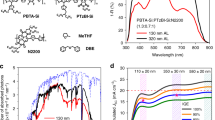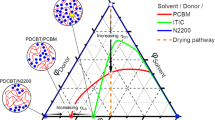Abstract
Bulk heterojunction solar cells have been extensively studied owing to their great potential for cost-effective photovoltaic devices. Although recent advances resulted in the fabrication of poly(3-hexylthiophene) (P3HT)/fullerene derivative based solar cells with efficiencies in the range 4.4–5.0%, theoretical calculations predict that the development of novel donor materials with a lower bandgap is required to exceed the power-conversion efficiency of 10%. However, all of the lower bandgap polymers developed so far have failed to reach the efficiency of P3HT-based cells. To address this issue, we synthesized a soluble, intensely coloured platinum metallopolyyne with a low bandgap of 1.85 eV. The solar cells, containing metallopolyyne/fullerene derivative blends as the photoactive material, showed a power-conversion efficiency with an average of 4.1%, without annealing or the use of spacer layers needed to achieve comparable efficiency with P3HT. This clearly demonstrates the potential of metallated conjugated polymers for efficient photovoltaic devices.
This is a preview of subscription content, access via your institution
Access options
Subscribe to this journal
Receive 12 print issues and online access
$259.00 per year
only $21.58 per issue
Buy this article
- Purchase on Springer Link
- Instant access to full article PDF
Prices may be subject to local taxes which are calculated during checkout






Similar content being viewed by others
References
Kim, J. Y. et al. New architecture for high-efficiency polymer photovoltaic cells using solution-based titanium oxide as an optical spacer. Adv. Mater. 18, 572–576 (2006).
Reyes-Reyes, M., Kim, K. & Carroll, D. J. High-efficiency photovoltaic devices based on annealed poly(3-hexylthiophene) and 1-(3-methoxycarbonyl)-propyl-1-phenyl-(6,6)C61 blends. Appl. Phys. Lett. 87, 083506 (2005).
Kim, Y. et al. A strong regioregularity effect in self-organizing conjugated polymer films and high-efficiency polythiophene:fullerene solar cells. Nature Mater. 5, 197–203 (2006).
Li, G. et al. High-efficiency solution processable polymer photovoltaic cells by self-organization of polymer blends. Nature Mater. 4, 864–868 (2005).
Li, G., Shortriya, V., Yao, Y. & Yang, Y. Investigation of annealing effects and film thickness dependence of polymer solar cells based on poly(3-hexylthiophene). J. Appl. Phys. 98, 043704 (2005).
Kim, Y. et al. Device annealing effect in organic solar cells with blends of regioregular poly(3-hexylthiophene) and soluble fullerene. Appl. Phys. Lett. 86, 063502 (2006).
Chirvase, D., Parisi, J., Hummelen, J. C. & Dyakonov, V. Influence of nanomorphology on the photovoltaic action of polymer–fullerene composites. Nanotechnology 15, 1317–1323 (2004).
De Bettignies, R., Leroy, J., Firon, M. & Sentein, C. Accelerated lifetime measurements of P3HT:PCBM solar cells. Synth. Met. 156, 510–513 (2006).
Mihailetchi, V. D. et al. Origin of the enhanced performance in poly(3-hexylthiophene):[6,6]-phenyl C61 butyric acid methyl ester solar cells upon slow drying of the active layer. Appl. Phys. Lett. 89, 012107 (2006).
Mihailetchi, V. D., Xie, H., de Boer, B., Koster, L. J. A. & Blom, P. W. M. Charge transport and photocurrent generation in poly(3-hexylthiophene):methanofullerene bulk heterojunction solar cells. Adv. Funct. Mater. 16, 699–708 (2006).
Koster, L. J. A., Mihailetchi, V. D. & Bloom, P. W. Ultimate efficiency of polymer/fullerene bulk heterojunction solar cells. Appl. Phys. Lett. 88, 093511 (2006).
Scharber, M. C. et al. Design rules for donors in bulk-heterojunction solar cells—towards 10% energy-conversion efficiency. Adv. Mater. 18, 789–794 (2006).
Wienk, M. M., Turbiez, M. G. R., Struijk, M. P., Fonrodona, M. & Janssen, R. Low-band gap poly(di-2-thienylthienopyrazine):fullerene solar cells. Appl. Phys. Lett. 88, 153511–153513 (2006).
Wang, X. et al. Infrared photocurrent spectral response from plastic solar cell with low-band-gap polyfluorene and fullerene derivative. Appl. Phys. Lett. 85, 5081–5083 (2004).
Wang, X. et al. Enhanced photocurrent spectral response in low-bandgap polyfluorene and C70-derivative-based solar cells. Adv. Funct. Mater. 15, 1665–1670 (2005).
Xia, Y. et al. Novel random low-band-gap fluorene-based copolymers for deep red/near infrared light-emitting diodes and bulk heterojunction photovoltaic cells. Macromol. Chem. Phys. 207, 511–520 (2006).
Zhou, Q. et al. Fluorene-based low band-gap copolymers for high performance photovoltaic devices. Appl. Phys. Lett. 84, 1653–1655 (2004).
Svensson, M. et al. High-performance polymer solar cells of an alternating polyfluorene copolymer and a fullerene derivative. Adv. Mater. 15, 988–991 (2003).
Shi, C., Yao, Y., Yang, Y. & Pei, Q. Regioregular copolymers of 3-alkoxythiophene and their photovoltaic application. J. Am. Chem. Soc. 128, 8980–8986 (2006).
Zhang, F. et al. Low-bandgap alternating fluorene copolymer/methanofullerene heterojunctions in efficient near-infrared polymer solar cells. Adv. Mater. 18, 2169–2173 (2006).
Hou, J. et al. Synthesis and photovoltaic properties of two-dimensional conjugated polythiophenes with bi(thienylenevinylene) side chains. J. Am. Chem. Soc. 128, 4911–4916 (2006).
Mühlbacher, D. et al. High photovoltaic performance of a low-bandgap polymer. Adv. Mater. 18, 2884–2889 (2006).
Zhang, F. et al. Polymer solar cells based on a low-bandgap fluorene copolymer and a fullerene derivative with photocurrent extended to 850 nm. Adv. Funct. Mater. 18, 2169–2173 (2006).
Brabec, C. J. et al. A low-bandgap semiconducting polymer for photovoltaic devices and infrared emitting diodes. Adv. Funct. Mater. 12, 709–712 (2002).
Shaheen, S. A. et al. Low band-gap polymeric photovoltaic devices. Synth. Met. 121, 1583–1584 (2001).
Xue, J., Uchida, S., Rand, B. P. & Forrest, S. R. 4.2% Efficient organic photovoltaic cells with low series resistances. Appl. Phys. Lett. 84, 3013–3015 (2004).
Robertson, N. Optimizing dyes for dye-sensitized solar cells. Angew. Chem. Int. Edn 45, 2338–2345 (2006).
Chawdhury, N. et al. Evolution of lowest singlet and triplet excited states with number of thienyl rings in platinum poly-ynes. J. Chem. Phys. 110, 4963–4970 (1999).
Köhler, A., Wittman, H. F., Friend, R. H., Khan, M. S. & Lewis, J. Enhanced photocurrent response in photocells made with platinum-poly-yne/C60 blends by photoinduced electron transfer. Synth. Met. 77, 147–150 (1996).
Guo, F., Kim, Y.-G., Reynolds, J. R. & Schanze, K. S. Platinum-acetylide polymer based solar cells: Involvement of the triplet state for energy conversion. Chem. Commun. 2006, 1887–1889 (2006).
Younus, M. et al. Synthesis, electrochemistry, and spectroscopy of blue platinum(II) polyynes and diynes. Angew. Chem. Int. Edn 37, 3036–3039 (1998).
Wilson, J. S. et al. Spin-dependent exciton formation in π-conjugated compounds. Nature 413, 828–831 (2001).
Manners, I. Putting metals into polymers. Science 294, 1664–1666 (2001).
Long, N. J. & Williams, C. K. Metal alkynyl σ complexes: Synthesis and materials. Angew. Chem. Int. Edn 42, 2586–2617 (2003).
Manners, I. Synthetic Metal-Containing Polymers (Wiley-VCH, Weinheim, 2004).
Köhler, A. & Beljonne, D. The singlet-triplet exchange energy in conjugated polymers. Adv. Funct. Mater. 14, 11–18 (2004).
Wong, W.-Y. Recent advances in luminescent transition metal polyyne polymers. J. Inorg. Organomet. Polym. Mater. 15, 197–219 (2005).
Karikomi, M., Kitamura, C., Tanaka, S. & Yamashita, Y. New narrow-bandgap polymer composed of benzobis(1,2,5-thiadiazole) and thiophenes. J. Am. Chem. Soc. 117, 6791–6792 (1995).
Roncali, J. Synthetic principle for bandgap control in linear π-conjugated systems. Chem. Rev. 97, 173–205 (1997).
Wong, W.-Y., Choi, K.-H., Lu, G.-L. & Shi, J.-X. Synthesis, redox and optical properties of low-bandgap platinum(II) polyynes with 9-dicyanomethylene-substituted fluorene acceptors. Macromol. Rapid Commun. 22, 461–465 (2001).
Bredas, J. L. Theoretical design of polymeric conductors. Synth. Met. 17, 115–121 (1987).
Köhler, A. et al. Donor-acceptor interactions in organometallic and organic poly-ynes. Synth. Met. 101, 246–247 (1999).
Bredas, J. L., Heeger, A. J. & Wudi, F. Towards organic polymers with very small intrinsic band gaps. I. Electronic structure of polyisothianaphthene and derivatives. J. Chem. Phys. 85, 4673–4678 (1986).
Havinga, E. E., Haeve, W. & Wynberg, H. Alternate donor-acceptor small-band-gap semiconducting polymers: Polysquaraines and polycroconaines. Synth. Met. 55–57, 299–306 (1993).
Kertesz, M. & Lee, Y.-S. Electronic structures of small gap polymers. Synth. Met. 28, C545–C552 (1989).
Wong, W.-Y. & Ho, C.-L. Di-, oligo- and polymetallaynes: Synthesis, photophysics, structures and applications. Coord. Chem. Rev. 250, 2627–2690 (2006).
Wilson, J. S. et al. The energy gap law for triplet states in Pt-containing conjugated polymers and monomers. J. Am. Chem. Soc. 123, 9412–9417 (2001).
Ashraf, R. S., Shahid, M., Klemm, E., Al-Ibrahim, M. & Sensfuss, S. Thienopyrazine-based low-bandgap poly(heteroaryleneethynylene)s for photovoltaic devices. Macromol. Rapid Commun. 27, 1454–1459 (2006).
van Duren, J. K. J. et al. Relating the morphology of poly(p-phenylene vinylene)/methanofullerene blends to solar-cell performance. Adv. Funct. Mater. 14, 425–434 (2004).
Mihailetchi, V. D. et al. Compositional dependence of the performance of poly(p-phenylene vinylene):methanofullerene bulk-heterojunction solar cells. Adv. Funct. Mater. 15, 795–801 (2005).
Shikler, R., Chiesa, M. & Friend, R. H. Photovoltaic performance and morphology of polyfluorene blends: The influence of phase separation evolution. Macromolecules 39, 5393–5399 (2006).
Huang, J., Li, G. & Yang, Y. Influence of composition and heat-treatment on the charge transport properties of poly(3-hexylthiophene) and (6,6)-phenyl C61–butyric acid methyl ester blends. Appl. Phys. Lett. 87, 112105 (2005).
von Hauff, E., Parisi, J. & Dyakonov, V. Investigations of the effects of tempering and composition dependence on charge carrier field effect mobilities in polymer and fullerene films and blends. J. Appl. Phys. 100, 043702 (2006).
Shrotriya, V. et al. Accurate measurement and characterization of organic solar cells. Adv. Funct. Mater. 16, 2016–2023 (2006).
Liu, Z. T., Kwok, H. S. & Djurišić, A. B. The optical functions of metal phthalocyanines. J. Phys. D 37, 678–688 (2004).
Acknowledgements
This work was supported by the Research Grants Council of The Hong Kong Special Administrative Region, China (Project Numbers HKBU 2024/04P, HKU 7008/04P and 7010/05P). Financial support from the Hong Kong Baptist University, the Strategic Research Theme, University Development Fund, a Seed Funding Grant and an Outstanding Young Researcher Award (administrated by The University of Hong Kong) are also acknowledged. The authors would like to thank J. Gao from the University of Hong Kong for step-profiler thickness measurements, A. M. C. Ng for ellipsometry measurements and W. C. H. Choy and HKU-CAS Joint Laboratory on New Materials and C. M. Che for the use of a glove box for encapsulation. The authors would also like to thank R. de Bettignies and S. Guillerez from CEA-INES RDI, Laboratoire Composants Solaires, in Bourges Du Lac, France for independent verification of the solar-cell results.
Author information
Authors and Affiliations
Contributions
X.-Z.W. and Z.H. were responsible for the synthesis and chemical analyses, C.-T.Y., K.-Y.C., H.W. and C.S.-K.M. carried out film and device fabrication and characterization, C.-T.Y., C.S.-K.M., A.B.D., W.-K.C. and W.-Y.W. were responsible for data analysis and interpretation, W.-Y.W., A.B.D. and W.-K.C. were responsible for project planning and experiment design and W.-Y.W. and A.B.D. were responsible for manuscript preparation.
Corresponding authors
Ethics declarations
Competing interests
The authors declare no competing financial interests.
Supplementary information
Supplementary Information
Supplementary information, figures S1-S6 and table S1 (PDF 305 kb)
Rights and permissions
About this article
Cite this article
Wong, WY., Wang, XZ., He, Z. et al. Metallated conjugated polymers as a new avenue towards high-efficiency polymer solar cells. Nature Mater 6, 521–527 (2007). https://doi.org/10.1038/nmat1909
Received:
Accepted:
Published:
Issue Date:
DOI: https://doi.org/10.1038/nmat1909
This article is cited by
-
Reversibly sensitizing-storing-releasing 1O2 within a single platinum(II)-acetylide-based metallacycle molecule via laser power modulation
Science China Chemistry (2024)
-
Conjugated Polymer Nanomaterials for Phototherapy of Cancer
Chemical Research in Chinese Universities (2020)
-
Ligand-induced symmetry breaking and concomitant blueshift in the emission wavelength of an octahedral chromium complex
Journal of Molecular Modeling (2018)
-
Functional Organometallic Poly(arylene ethynylene)s: From Synthesis to Applications
Topics in Current Chemistry (2017)
-
Pentacene- and BODIPY-Containing trans-Bis(ethynyl)bis(phosphine)platinum(II) Organometallic Polymers: A DFT Point of View
Journal of Inorganic and Organometallic Polymers and Materials (2016)



